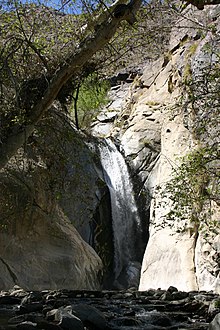Tahquitz Falls
| Tahquitz Falls | |
|---|---|
 Tahquitz Falls, facing west | |
| Location | Tahquitz Canyon |
| Coordinates | 33°48′13″N 116°33′42″W / 33.8036°N 116.5617°WCoordinates: 33°48′13″N 116°33′42″W / 33.8036°N 116.5617°W |
| Type | Staircase |
| Elevation | 890 ft (270 m) |
| Total height | 60 ft (18 m) |
Tahquitz Falls is a waterfall on Tahquitz Creek in the west skirt of the city Palm Springs, in the U.S. state of California. The waterfall is located in lower Tahquitz Canyon, a short distance upstream from the visitor center. The name of the canyon and its waterfall is from the spirit Tahquitz, a Cahuilla native of the Agua Caliente folklore.[1]
The river flows over a slab of granite atop the falls, after which it plunges about 60 feet (18 m)[2] into a pool. The fall is split once by a protrusion on the face of the canyon wall. The Tahquitz Falls is in the boundaries included in the National Register of Historic Places.
Access[]
The falls are easily reached by proceeding upstream along the Tahquitz Canyon Trail. The trail gains approximately 350 feet (110 m) in altitude and runs past the waterfall forming a loop that returns to the waterfall and to the Visitor Center.[1] The canyon and its trail are owned and managed by the Agua Calientes Band of Cahuilla Indians.[3]
In popular culture[]
The Tahquitz Falls were used as a scene in Frank Capra's 1937 film, Lost Horizon.[4]
See also[]
- Tahquitz (spirit), the Cahuilla spirit the falls were named for.
References[]
- ^ a b Lister, Priscilla (22 Feb 2013). "Palm Springs hiking, from sand to snow". The San Diego Union-Tribune. Retrieved 29 August 2017.
- ^ "Tahquitz Falls Riverside County, California". Northwest Waterfall Survey. Retrieved 29 August 2017.
- ^ Schad, Jerry (23 Dec 2004). "From hippie hangout to Indian natural preserve, Tahquitz Canyon outside Palm Springs remains a popular place to visit". San Diego Reader. Retrieved 29 August 2017.
- ^ Lost Horizon at the American Film Institute Catalog
| Wikimedia Commons has media related to Tahquitz Falls. |
- Waterfalls of California
- Geography of Riverside County, California
- Geography of the Colorado Desert
- Palm Springs, California
- Agua Caliente Band of Cahuilla Indians
- Coachella Valley
- Plunge waterfalls

